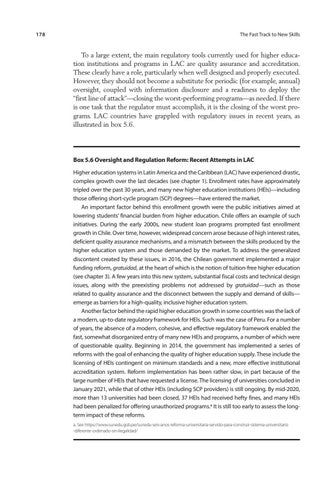178
The Fast Track to New Skills
To a large extent, the main regulatory tools currently used for higher education institutions and programs in LAC are quality assurance and accreditation. These clearly have a role, particularly when well designed and properly executed. However, they should not become a substitute for periodic (for example, annual) oversight, coupled with information disclosure and a readiness to deploy the “first line of attack”—closing the worst-performing programs—as needed. If there is one task that the regulator must accomplish, it is the closing of the worst programs. LAC countries have grappled with regulatory issues in recent years, as illustrated in box 5.6.
Box 5.6 Oversight and Regulation Reform: Recent Attempts in LAC Higher education systems in Latin America and the Caribbean (LAC) have experienced drastic, complex growth over the last decades (see chapter 1). Enrollment rates have approximately tripled over the past 30 years, and many new higher education institutions (HEIs)—including those offering short-cycle program (SCP) degrees—have entered the market. An important factor behind this enrollment growth were the public initiatives aimed at lowering students’ financial burden from higher education. Chile offers an example of such initiatives. During the early 2000s, new student loan programs prompted fast enrollment growth in Chile. Over time, however, widespread concern arose because of high interest rates, deficient quality assurance mechanisms, and a mismatch between the skills produced by the higher education system and those demanded by the market. To address the generalized discontent created by these issues, in 2016, the Chilean government implemented a major funding reform, gratuidad, at the heart of which is the notion of tuition-free higher education (see chapter 3). A few years into this new system, substantial fiscal costs and technical design issues, along with the preexisting problems not addressed by gratuidad—such as those related to quality assurance and the disconnect between the supply and demand of skills— emerge as barriers for a high-quality, inclusive higher education system. Another factor behind the rapid higher education growth in some countries was the lack of a modern, up-to-date regulatory framework for HEIs. Such was the case of Peru. For a number of years, the absence of a modern, cohesive, and effective regulatory framework enabled the fast, somewhat disorganized entry of many new HEIs and programs, a number of which were of questionable quality. Beginning in 2014, the government has implemented a series of reforms with the goal of enhancing the quality of higher education supply. These include the licensing of HEIs contingent on minimum standards and a new, more effective institutional accreditation system. Reform implementation has been rather slow, in part because of the large number of HEIs that have requested a license. The licensing of universities concluded in January 2021, while that of other HEIs (including SCP providers) is still ongoing. By mid-2020, more than 13 universities had been closed, 37 HEIs had received hefty fines, and many HEIs had been penalized for offering unauthorized programs.a It is still too early to assess the longterm impact of these reforms. a. See https://www.sunedu.gob.pe/sunedu-seis-anos-reforma-universitaria-servido-para-construir-sistema-universitario -diferente-ordenado-sin-ilegalidad/

